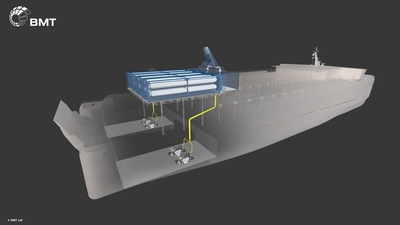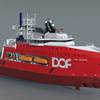Report: Options for Retrofitting Ro-Pax with Hydrogen Propulsion Analyzed
BMT and PA Consulting have explored the feasibility of retrofitting medium-sized Ro-Pax ferries with hydrogen propulsion and storage technology.
The resulting white paper assesses the economic and technical feasibility of retrofitting existing vessels with hydrogen propulsion systems, presenting three retrofit alternatives with varying complexity, hydrogen demand and costs. These options involve dual-fuel engines with compressed gaseous hydrogen storage, hydrogen fuel cells with liquefied hydrogen storage and internal combustion engines running on 100% hydrogen with liquefied hydrogen storage.
The white paper, 'Feasibility of retrofitting medium-sized Ro-Pax ferries to utilise hydrogen propulsion and storage technology,' employs an 85-meter Ro-Pax catamaran as a case study, analyzing the vessel's characteristics, operational profile, and potential for retrofitting. The vessel's size, speed and operational frequency make it an ideal candidate for transitioning to hydrogen propulsion. The study considers three retrofit options, incorporating technoeconomic modelling to assess costs and benefits.
The study provides a comprehensive review of hydrogen production pathways, focusing on green and blue hydrogen. It explores various hydrogen propulsion options, comparing fuel cells and internal combustion engines. Onboard hydrogen storage options, including compressed and liquefied hydrogen, are analyzed, considering factors such as space, safety, and retrofit challenges.
A critical factor in the study is the availability of hydrogen for refueling across the vessel's operational profile. The analysis considers scenarios where hydrogen is produced both locally and offsite, assessing the impact of transportation on total cost of ownership. The study underscores the importance of minimizing hydrogen transportation distances for economic viability.
The study evaluates the levelized cost of hydrogen for different production methods, comparing blue and green hydrogen, and assesses this against the fuel cost for MGO. The additional impact of subsidies on the cost of hydrogen fuel is also assessed. This is combined with an assessment of the capital cost of conversion and other OPEX to assess the total cost of ownership over the vessel lifetime.
The white paper concludes that hydrogen fuel cells offer a cost-effective propulsion solution for the studied vessel on a total-cost-of-ownership basis over its lifetime when compared to continued use of MGO. The analysis also shows that while costs for low-carbon fuels are currently higher than fossil alternatives, factors such as technology advancement and carbon pricing are expected to drive down this cost differential in the coming years. The study emphasizes the need for subsidies, strategic co-location of hydrogen assets, and ongoing advancements in hydrogen technology for long-term viability.
The study acknowledges the challenges of integrating hydrogen technology into existing ships but underscores the potential benefits for decarbonization. The white paper also incorporates detailed modelling of the cost of hydrogen production over a typical vessel lifetime. The model considers techno-economics, hydrogen production pathways and government policies, tailoring the analysis to the vessel's operational requirements.
Ro-Pax ferries contribute 37 million tonnes of CO2 annually.















